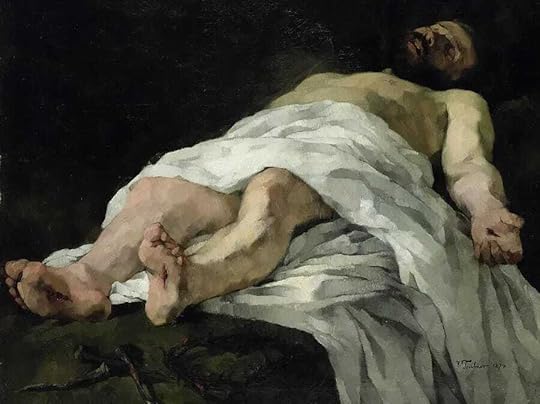The Tomb Becomes Empty As The Temple Was Empty

If you appreciate the work, consider becoming a paid subscriber.
This painting is "The Dead Christ" (1875) by Vasili Ivanovich Surikov, a Russian realist painter known for his historical scenes and dramatic use of light and composition. The image depicts Christ's lifeless body after the Crucifixion, rendered with raw emotional intensity and anatomical realism, emphasizing the human suffering of the subject.
At some point after three in the afternoon on Good Friday, Joseph of Arimathea and Nicodemus lay to rest the body of the dead Jesus in a newly hewn garden tomb. The corpse of Mary’s boy and Pilate’s victim would have appeared similar to how Surikov depicts it in “The Dead Christ.”
From Friday afternoon onward, Jesus is every bit as dead as one day you will be dead.
He is finished.
But at some point— like Marty McFly’s family in the photograph— as Holy Saturday turns to the third day, the tomb no longer looks the way Surikov paints it. Whither the corpse of Christ? Does it disappear only to reappear, as with the breaking of bread on the road to Emmaus? Does the dead Jesus, as it were, “wake up,” roll away the stone, and walk out of the tomb like the astonished Lazarus in his grave clothes? Or is the body of the dead Jesus transfigured?
The Gospel of John provides a clue in his resurrection account; the passage assigned for Easter Sunday functions also as a story for Holy Saturday, making Easter more mysterious than simply a merciful surprise.
If you read John’s Gospel closely, the tomb is not empty.
It is full.
Notice the detail John gives you.
First, Mary faces the tomb and addresses the angels, “They have taken away my Lord, and I do not know where they have laid him.” Next, verse fourteen, John tells you that Mary turns. Her back is to the tomb now. And Mary “sees” Jesus but she doesn’t recognize him as Jesus. Supposing him to be the gardener, she says to the man in front of her, “Sir, if you have taken him away, tell me where you have laid him, and I will take him away.”
And then— pay attention, John reports in verse sixteen that Jesus says to her, “Mary.”
And Mary turns, John says.
She turns in the direction of his voice.
She turns towards the tomb so that her back is again to the man she took for the gardener. Mary’s facing the tomb when she says, “Rabboni! Teacher!” She’s talking to the tomb. And it’s from that same direction that the voice of the Risen Christ corrects her, “Do not cling to me.”
Mary’s facing the tomb when she says, “Rabboni! Teacher!”
But again, notice— John hasn’t said a word about Mary grasping anyone. Rather, she’s facing the tomb and addressing him as “Teacher,” and he replies, “Do not cling to me.”Which is to say, “I am not who you have known me to be. I am more than you have known me to be. I am free of even your memories of me.”
And then Mary turns again and she runs. And she tells the disciples, no longer calling him “my lord” but “The LORD.”
The LORD.
That is, she identifies the Risen Jesus with the LORD who dwelt invisibly in the Temple, the God whose presence looked like absence.
Thus, just as the resurrection requires Christians to rework our assumptions of what constitutes a “body,” our definition of the empty tomb must be more nuanced.
As Robert Jenson concludes his chapter “Resurrection:”
“The organism that was Jesus’ availability— that was his body— until he was killed would have as a corpse continued to be an availability of this person, of the kind that tombs and bodies of the dead always are. It would have been precisely a relic; such as the saints of all religions have. Something other sacrament and church would have located the LORD for us, would have provided a direction for devotion; and that devotion wold have been to a saint, and so would have been something other than faith and obedience to a living LORD.
The tomb, we may therefore cautiously judge, had to be empty after the Resurrection for the Resurrection to be what it is. We can, of course, say nothing at all about what anyone would have seen who was in the tomb between the burial and the first appearances.
If the tomb marked by the Church of Holy Sepulcher is indeed where Christ lay, then it is empty not by inadvertence but as the Temple of Israel was empty.”
 Get more from Jason Micheli in the Substack appAvailable for iOS and AndroidGet the app
Get more from Jason Micheli in the Substack appAvailable for iOS and AndroidGet the app
Jason Micheli's Blog
- Jason Micheli's profile
- 13 followers



